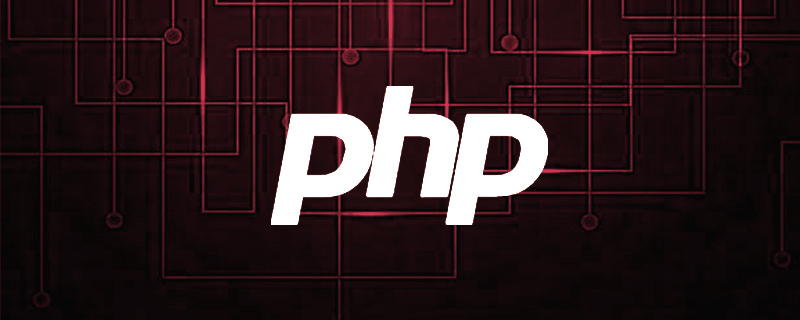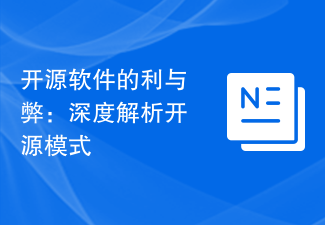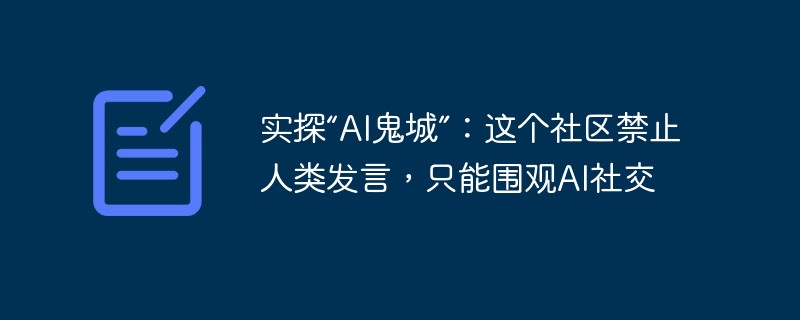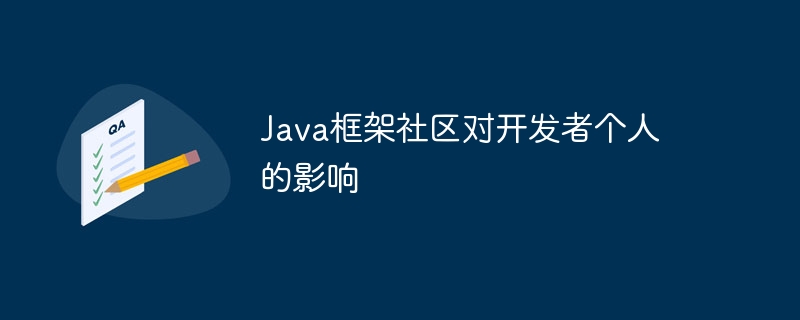In the current period of rapid development of Internet business, new products are springing up like mushrooms after a rain, and old product lines and new businesses are also constantly making breakthroughs and attempts. This puts forward higher requirements for rapid development iteration.
1. Basic operating environment
For the development of new products, it is necessary to be able to quickly build a LAMP architecture. Then it is nothing more than choosing a webserver, choosing a PHP version, choosing a MySQL version, then choosing a PHP development framework and choosing some PHP general extensions and basic libraries. Readers may think that this process is already very fast. Can it be faster?
The selection process requires R&D students to have a certain accumulation of relevant technical directions, weigh the pros and cons and priorities, and it is also a period of research and study. If there is a one-click installation program that provides automated installation of webserver, PHP, and MySQL, as well as a high-performance and flexible PHP development framework, and provides standardized, safe, and commonly used configuration files, it can greatly shorten the cost of product line LAMP system research and shorten the work cycle. .
Four steps for one-click installation: (1) download; (2) a small amount of configuration; (3) make install; (4) start; (of course there is end, a simple operation and maintenance tool), and the running environment is OK.
2. Business development framework
The community product lines are independent and have to develop their own business logic in a closed manner. In fact, there are many common business logic processes between various product lines, such as session verification, permission judgment, parameter verification, log printing, etc. For different product lines, all requests need to be processed. Can we not repeat the development? There are many differences between wireless business development and PC business logic, but there are also many commonalities between different product lines. Can we not repeat development?
The product line usually abstracts the processing of these general logic to a certain extent internally, and designs it in the form of ActionChain or through base class solutions. The framework will be more thorough: the common logic that must be processed by all requests is provided in the form of a business logic framework, and R&D students only need to focus on the logic processing specific to user requests.
The processing logic of a user request is as follows: the blue part is the controller framework processing flow, and the green part is combined with the controller framework to process the common business logic of all requests. The user who really needs the attention and development of R&D students requests proprietary business processing, that is, the yellow part (of course, one is not just an Action script, the processing of a request will be horizontally layered with MVC, which will be covered later.)
Business logic framework inheritance is provided in the one-click installer, which is easy to obtain.
The native PHP business and templates are deeply coupled without any layered design. The result is poor code reusability. Such original PHP systems are almost extinct now. The PHP development framework uniformly handles routing, rendering, AutoLoad, abstraction of general business logic and basic libraries, and proprietary business MVC layering, which has greatly accelerated the development of product line business logic. As shown below:

From top to bottom, they are the access layer (high-performance webserver), PHP development framework (routing, automatic loading, view engine, etc.), application and basic libraries, and storage engine.
3. General services
Community product lines have many common needs, such as log processing, configuration file processing, string processing, database interaction, network interaction, etc. These algorithms and tools are packaged into phplib and are relatively mature for use in product lines.
The business functions of community product lines have a lot of commonality, such as comment function, tag function, friend function, album, task system, etc. Many community product lines have similar new functions and new requirements, and they are designed and developed separately. ?
These requirements have personalized requirements on the UI of each product line, but the back-end implementation solutions are similar and have a certain degree of versatility. Functional servitization provides API interfaces for use by different product lines. The product lines only need to focus on the display logic and private data processing logic, and the services are operated and maintained in a unified manner to reduce the system complexity under the product.
4. Vertically split subsystems
As our business expands, the number of UIs and modules within a single application increases, and the interaction between Action and Logic (corresponding to the M layer in MVC, which can be further layered internally, will not be detailed this time) , the interaction between logic and logic is becoming more and more complex. Developers need to understand the logic of the entire application. To upgrade a certain logic, you need to check whether there are reverse dependencies on other UI or logic in the entire application. Under the requirements of rapid development, developers do not have a clear understanding of the coupling relationship between logic, which will inevitably cause more and more problems, affect the quality of the project, and make it difficult to start development.
As more and more problems are exposed in a single system, it’s time to split the system. How to dismantle? Split vertically by business logic. Separate functionally independent business logic into independent subsystems. At this time, we also need to consider the versatility of the business. Can it be service-oriented? Does the application already have a common service with the same needs? At this time, the general business logic is encapsulated into a general service or uses a general service, and the bypassed business logic is independently divided into subsystems. This reduces a lot of burden on the original single and huge system. After completing this stage of reconstruction, the system will become as follows:
A single system is split into multiple APPs (there is still a horizontal MVC layer inside the APP), and a large number of common services are reused. As a result, the R&D team has greatly improved its division of labor and parallel development.
5. Cross-system call framework
However, the actual situation is that dependencies between split subsystems cannot be completely eliminated. In order to solve the data dependency relationship between multiple subsystems, a unified solution is needed: API framework. Subsystems become independent applications (APPs), and there are mutual data dependencies between APPs, and these dependencies are provided externally in the form of APIs. As shown below:
When APP1 relies on the data of APP2 or APP3, APP2 and APP3 will provide part of the data interface in the form of API, the data will be packaged uniformly, and other APP calls within the product line will be provided through standard URLs. This form is very similar to a product's open API (open API to third parties, we call it openAPI, comply with a unified protocol, and undergo necessary permission verification), and the API interface that solves the data dependencies between internal subsystems can be further simplify.
The API provided by the APP provides interface description (input, output), processing API URL, and Logic forwarding implementation. API_LIB manages all API interfaces in a unified way and provides a unified API_Server::call interface for calling. Completely aligns with the internal forwarding and implementation details of the shield. Usually, in order to simplify and unify the operation and maintenance within the product line, all subsystems are deployed on the same machine. The API interface will bring additional network consumption and increase qps. Under this deployment premise, API_Server can be implemented through HTTP calls or optimized to direct PHPRequire. Advantages:
(1) Framework unification, interface convergence, and business decoupling;
(2) Improved performance, high ease of use, and high scalability;
6. UI split model
At this time, the independent subsystem can focus on its business logic, and the burden on the core system is also reduced. However, the core system has the highest frequency of upgrades and updates, and the business logic is also the most complex. After a certain period of time, the core system becomes bloated and difficult to maintain. At this time, some design patterns can be used to reduce the scalability and maintainability of the program. But even so, there is still a certain learning cost. Within an App, developers need to pay more or less attention to the code of other modules. As it gradually develops, upgrading will require troubleshooting many points. It’s time to further reduce the burden. What if the burden is reduced? Divided into two parts:
Step One: Asynchronous Model
Page rendering is divided into two stages: topic page data and other non-topic page data. Data is provided by different data sources based on different parts of the page. According to this logic, the app will be further divided vertically.

PHPService is composed of PHPmodule + a thin layer of UI to return formatted data.
Step 2: Synchronize the model
Module splitting, different business logic is split into different Modules, divided into multiple data sources, each providing different data content. After the unified UI schedules different data sources, the unified rendering page returns a response.

After such continuous load reduction, there will be more and more subsystems and modules within the product line, and it is necessary to maintain the unity of deployment and operation and maintenance. The division of labor among team members is very detailed, the business understanding is very focused and in-depth, and the efficiency of cooperation and parallelism will be higher, thus shortening the entire development cycle.
7. Summary
As business logic grows, if the business functions of each subsystem or module are too bloated, they need to be continuously reduced to keep them within a controllable scale. As the product develops, there will be more and more subsystems and modules within the product line, and deployment and operation and maintenance need to be unified and kept simple. The division of labor among team members is more detailed, the business understanding remains focused and in-depth, and the efficiency of cooperation and parallelism will be higher, thus shortening the entire development cycle.
by luhaixia
 php怎么把负数转为正整数Apr 19, 2022 pm 08:59 PM
php怎么把负数转为正整数Apr 19, 2022 pm 08:59 PMphp把负数转为正整数的方法:1、使用abs()函数将负数转为正数,使用intval()函数对正数取整,转为正整数,语法“intval(abs($number))”;2、利用“~”位运算符将负数取反加一,语法“~$number + 1”。
 php怎么设置implode没有分隔符Apr 18, 2022 pm 05:39 PM
php怎么设置implode没有分隔符Apr 18, 2022 pm 05:39 PM在PHP中,可以利用implode()函数的第一个参数来设置没有分隔符,该函数的第一个参数用于规定数组元素之间放置的内容,默认是空字符串,也可将第一个参数设置为空,语法为“implode(数组)”或者“implode("",数组)”。
 php怎么给数组增加一个数组元素Apr 19, 2022 pm 08:45 PM
php怎么给数组增加一个数组元素Apr 19, 2022 pm 08:45 PM增加元素的方法:1、使用“array_unshift(数组,数组元素)”语句,在数组的开头添加元素;2、使用“array_push(数组,数组元素)”语句,在数组的末尾添加元素;3、用“array_pad(数组,数组长度+1,元素)”语句。
 php怎么统计数组里同一个值有几个Apr 19, 2022 pm 08:26 PM
php怎么统计数组里同一个值有几个Apr 19, 2022 pm 08:26 PM在php中,可以使用array_count_values()函数来统计数组里同一个值有几个,语法为“array_count_values($array)”;该函数会返回一个关联数组,其元素的键名是原数组的值,键值是该值在原数组中出现的次数。
 开源软件的利与弊:深度解析开源模式Feb 24, 2024 pm 02:51 PM
开源软件的利与弊:深度解析开源模式Feb 24, 2024 pm 02:51 PM开源软件的优点与弱点:解析开源模式的利与弊,需要具体代码示例在当今数字化信息时代,开源软件正逐渐成为软件开发的主流趋势。开源软件指的是其源代码可被公开查看、使用、修改和分发的软件。相比于传统的闭源软件,开源软件具有诸多优点,但同时也存在一些弱点。本文将从开源软件的优点和弱点两个方面展开讨论,同时结合具体代码示例,深入探究开源模式的利与弊。首先,让我们从开源软
 实探“AI鬼城”:这个社区禁止人类发言,只能围观AI社交May 30, 2023 pm 11:41 PM
实探“AI鬼城”:这个社区禁止人类发言,只能围观AI社交May 30, 2023 pm 11:41 PM有这样一个AI专属的社交平台,近日正在悄悄扩张。它名为“Chirper”,中文意为动物昆虫叫声的拟声词,官方翻译为“奇鸟”。网站域名在4月20日注册,上线不到一个月,平台中的AI就已经产生上亿条包含文字、图片、转评赞等社交行为的推文信息。——是的,支撑着这一社交平台运转的,无一例外全是AI。与此同时,平台对全体人类“禁言”,使其无法发言或进行任何社交行为,人们只能不断刷新首页,围观AI们的社交行为。那么,这个号称“禁止人类入内”的平台中真的只有AI吗?这些AI如何诞生?又如何进行争吵、互赞、甚至
 PHP开发技术:打造一个网络问答社区Oct 27, 2023 am 11:05 AM
PHP开发技术:打造一个网络问答社区Oct 27, 2023 am 11:05 AMPHP开发技术:打造一个网络问答社区随着互联网的快速发展和信息的爆炸式增长,网络问答社区逐渐成为人们获取知识和解决问题的主要方式。在这样的背景下,利用PHP开发技术来打造一个高效、稳定的网络问答社区成为了一个具有吸引力的项目。一.社区特点及需求分析在开始开发之前,我们首先要明确社区的特点和用户需求,以确保开发的方向和目标清晰明确。1.用户黏性高:一个好的问答
 Java框架社区对开发者个人的影响Jun 03, 2024 pm 03:53 PM
Java框架社区对开发者个人的影响Jun 03, 2024 pm 03:53 PMJava框架社区对个人开发者有重大影响,通过以下方式:职业发展:提升就业机会,专业化和认证,网络和指导关系提升技术技能:持续学习,了解新技术,解决复杂问题参与开源项目:贡献代码,分享知识,接受挑战


Hot AI Tools

Undresser.AI Undress
AI-powered app for creating realistic nude photos

AI Clothes Remover
Online AI tool for removing clothes from photos.

Undress AI Tool
Undress images for free

Clothoff.io
AI clothes remover

AI Hentai Generator
Generate AI Hentai for free.

Hot Article

Hot Tools

Dreamweaver CS6
Visual web development tools

Zend Studio 13.0.1
Powerful PHP integrated development environment

Safe Exam Browser
Safe Exam Browser is a secure browser environment for taking online exams securely. This software turns any computer into a secure workstation. It controls access to any utility and prevents students from using unauthorized resources.

SublimeText3 Mac version
God-level code editing software (SublimeText3)

Atom editor mac version download
The most popular open source editor






